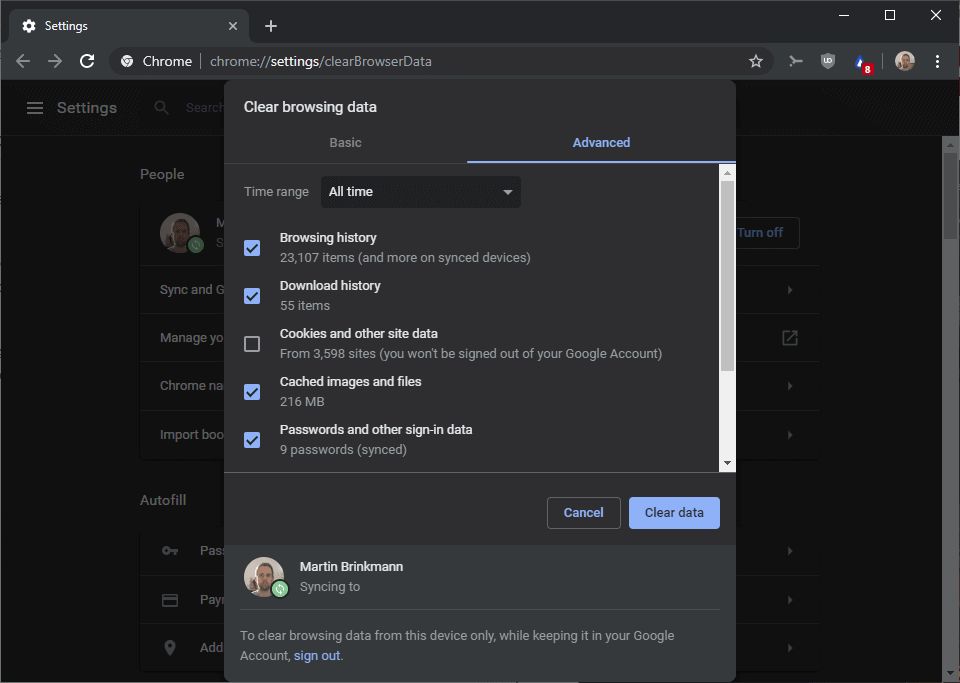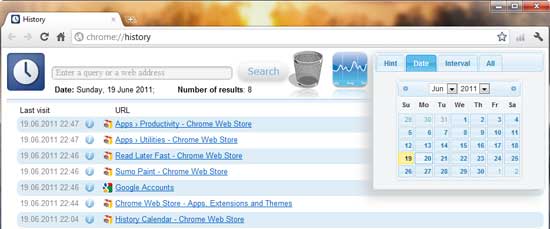Chrome Browser History By Date
Now open the history page again. You can do this by typing chrome://history/ in address bar. Or press CTR+H.You will see the different history page. At the left side, you can see the date filters. You can select any date. Default date options are given by 7 days interval. From the calendar option, you can select specific date. ChromeHistoryView is a small utility that reads the history data file of Google Chrome Web browser, and displays the list of all visited Web pages in the last days. For each visited Web page, the following information is displayed: URL, Title, Visit Date/Time, Number of visits, number of times that the user typed this address (Typed Count), Referrer, and Visit ID. Internet browsers such as Internet Explorer, Mozilla Firefox and Google Chrome keep a list of web sites you visit. This list is called your browsing history. In addition to the website's title and address, browsers also record the time stamp, the time the website was visited. Find the time stamp of a Web browser.
Bear in mind that today (Feb 2018), and for quite a few months now, Chrome allows you to link a device's data (history, bookmarks, etc), with an account. So, you can sync a google account with a device and then you can access all that information from any other device using that account. I know the question was about exporting it but there is REALLY no need to do that (I was obviously making myself the same question today, which got me here, but then I thought that there should be a better way, this is it).–Feb 28 '18 at 11:20. It's even simpler than using an extension: the History page in Chrome is already an HTML page, as are all the other panes and pages in Chrome.Simply right-click on an empty part of the page, select Save As. And save as full HTML. If you re-open in Chrome, it'd render the same, icons and all.
If you try opening the resulting page in a different browser, you'd still get all the history data, just not the styles and icons.Update May 2016Since Google constantly changes the way internal pages (history, bookmarks, settings etc.) are rendered, the original answer is no longer accurate. In Chrome 52 (May 2016) the History URLs appear inside an iframe with a paging mechanism.For posterity's sake, the best method to get all the bookmarks data (url + date) as a CSV file is described.TL;DR:. Make sure you have installed in your system. You can use compiled binaries for Windows systems. Locate the History file (on Mac: cd /Library/Application Support/Google/Chrome/Default/.
On Windows: cd '%LocalAppData%GoogleChromeUser DataDefault'. Copy the file History to another location (you can't use the original while Chrome is open). From a command line:C: sqlite3 Historysqlite.headers onsqlite.mode csvsqlite.output my-history.csvsqlite SELECT datetime(lastvisittime/104473600,'unixepoch','localtime'), url FROM urls ORDER BY lastvisittime DESCYou should now have a file called my-history.csv containing all URLs and dates.Script as a gist can be found.Hopefully this works for you in 2016. Can't promise it will in 2019 though:). In Mac: cd '/Library/Application Support/Google/Chrome/Default'sqlite3 History 'select datetime(lastvisittime/104473600,'unixepoch'),url from urls order by lastvisittime desc' /historyexport.txtIn Windows: cd '%LocalAppData%GoogleChromeUser DataDefault'sqlite History 'select datetime(lastvisittime/104473600,'unixepoch'),url from urls order by lastvisittime desc' historyexport.txtThis could take a really long time if you are on Windows and do not have SSD.
If you don’t want a record of webpages you’ve visited using Chrome, you can delete all or some of your browsing history. Deleting your browsing history will take effect on all devices where you’ve turned sync on in Chrome.Your history will be removed from Chrome. Separately, y ou can also from your account. Episode keberapa luffy bertemu hancock youtube.

See your history. On your computer, open Chrome.

At the top right, click More. Click History History.Clear your history. On your computer, open Chrome. At the top right, click More. Click History History. On the left, click Clear browsing data.
A box will appear. From the drop-down menu, select how much history you want to delete. To clear everything, select All time. Check the boxes for the info you want Chrome to clear, including “browsing history.'
. Click Clear data.To delete your search history, learn about. Delete an item from your historyYou can delete certain parts of your history. To search for something specific, use the search bar at the top. On your computer, open Chrome. At the top right, click More. Click History History.
Check the box next to each item that you want to remove from your History. At the top right, click Delete. Confirm by clicking Remove.Remove an image from New Tab pageTo see the sites you visit most,. To remove an image, point to it and click Remove. What your history page showsYour History page shows the webpages you've visited on Chrome in the last 90 days. It doesn’t store Chrome pages you’ve visited like chrome://settings, pages you've visited in Incognito mode, or pages you've already deleted from your browsing history.If you're signed in to Chrome and syncing your history, then your History page shows webpages you’ve visited across all your synced devices for much longer.Browse privatelyIf you don’t want Chrome to save your browsing history at all, you can.Using a Chromebook at work or school?
Chrome Browser History By Date Search

Google Chrome History By Date
Your network administrator can turn off browsing history. If history is off, your History page won't list webpages you've visited.